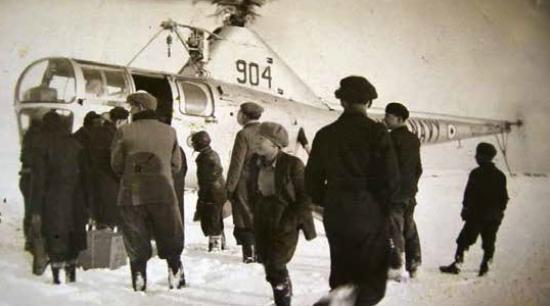Operation Snowdrop, 1955
7th February 2016

This article was submitted by the author Brian Hawkins who is a retired BBC engineer and published the article in the magazine of retired BBC pensioners in February 2016. - Prospero
As the year 2015 came to an end, we read and heard that it was likely to have been one of the warmest on record. Brian Hawkins looks back over 60 years to a year which started out as one of the coldest, and to his involvement in Operation Snowdrop whilst he was serving in the Royal Navy on his National Service engagement.
In early January 1955 I was returning from Christmas leave to my ship, HMS Glory, a light fleet carrier, which had distinguished herself in the then recent Korean campaign. Berthed in the Royal Naval Dockyard Portsmouth, in the shadow of Nelsons flagship Victory, Glory was preparing to join the reserve fleet after returning just before Christmas from a trip to Singapore, no longer as an operational carrier with a complement of aircraft, but from a trooping assignment. However, adverse weather conditions dictated a change of plan - Glory was to be deployed on a humanitarian mission and join Operation Snowdrop. The weather conditions in Scotland had been severe. The country north of the Caledonian Canal was
virtually cut off from the rest of Scotland.
Relief operations by the Royal Air Force had already started from Kinloss, and from Wick Airport two Royal Navy Whirlwind
helicopters were dropping essential supplies to villages isolated by 10-foot snowdrifts. Meanwhile we in Glory sailed from
Portsmouth for Port Glasgow, where we embarked supplies of food, animal fodder, aviation spirit and medical supplies. From Glasgow we steamed north, our destination Loch Eriboll, Scotlands most northerly sea loch. Here we set up a base from which Royal Navy helicopters could more easily drop supplies to the most northerly villages and crofts.
The voyage north was quite spectacular, sailing within sight of the Scottish mainland and the nearby islands. The snow-covered landscapes to each side of us dazzling in the bright sunshine under a clear blue sky. We were enjoying the sort of environment that cruising holidaymakers pay thousands to be part of. Loch Eriboll, as well as being the most northerly, is certainly the biggest sea loch, being a deep finger of inland sea almost 10 miles in length. Anchored in its mouth was to be
Glorys home for the next few days.
The depth of the snow on the land each side of us created a strange acoustic effect, an uncanny silence only to be disturbed by the low frequency throb of Whirlwind helicopters approaching our flight deck. One particular day, the Whirlwinds dropped over 3000lbs of supplies, including cattle food and kerosene, to 34 villages. Glory remained on station for over a week. The operation went off without a mishap, apart from one Naval Officer dislocating his shoulder jettisoning a bale of hay from one of the Whirlwinds!
Then suddenly, overnight I seem to recall, a dramatic thaw set in and the next morning revealed on both sides the surrounding expanse of soft green and brown countryside. There is a certain eeriness about the atmosphere of the Loch,which was well known to the Royal Navy in both World Wars as a secure anchorage for the largest of vessels. On a melancholy note, in May 1941 the battleship HMS Hood had moored there, which gave her crew a chance to go ashore.
There was not much ashore to entertain them, but at least they were able to enjoy being on dry land. Just days later in the Battle of Denmark Strait, Hood was sunk by enemy action with the loss of 1,413 hands. There were three survivors. Four years later, 33 German U-boats assembled in the Loch and finally surrendered, marking the end of the Battle of the Atlantic. Once the thaw had set in and other supply lines had been established, Scotland slowly returned to normality, although flooding became the next concern. We in Glory left the tranquillity of the Loch and steamed eastwards along the north coast of the country, rounding Duncansby Head, and then south to the Firth of Forth. As we changed course to enter the estuary I remember the concerns about the height of the mast of Glory, the state of the tide and clearance under that impressive cantilevered rail bridge. The very topmost section of our ships mast was designed to fold down in such circumstances.
Although I was not directly involved with this manoeuvre I gather that great frustration was involved in endeavouring to carry it out as the result of many layers of paint having been applied to the mast over the years. With much relief we passed under the bridge and eventually we berthed in the Royal Naval Dockyard at Rosyth. Over the next weeks the ship was gradually decommissioned until it was time for me and my National Service colleagues to be drafted south to the Royal Naval Barracks, Chatham.
It was a sad day in February 1955 when we left the ship. My last glimpse of Glory as we drove away, framed by the archway of the dockyard gate, was of her topmast pointing proudly to the sky, a reminder of that spectacular bridge we had passed under on our recent voyage. Glory had a distinguished record. She had been an operational carrier for 11 years, had witnessed on-board the signing of the surrender of the Japanese Army, had been engaged in the repatriation of prisoners that had been held in the Far East and had made the largest single contribution of any Commonwealth Aircraft Carrier during the Korean War.
Operation Snowdrop was almost Glorys swan song. In 1956 she had a brief commission, after which she remained on the Reserve Fleet, a sad sight rusting away on a mooring on the Firth of Forth, until she was broken up at Inverkeithing in August 1961.



